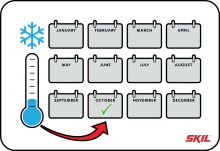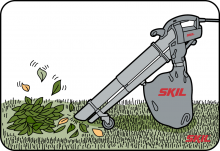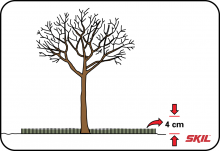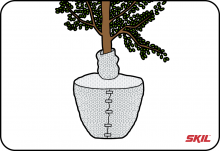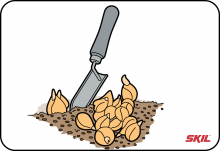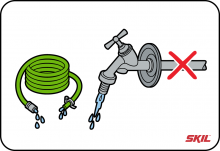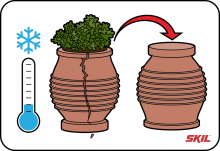-
Why should you get your garden ready for winter?
Did you know you can work on your garden in the autumn to ensure it’s clean and tidy the following spring? You should do this before the winter starts. That saves you a lot of extra work in the spring and ensures your garden grows and blooms beautifully. You can also minimise and in some cases completely rule out the risk of damage by frost over the winter.
-
When should you get your garden ready for winter?
You don’t have to get your garden ready for winter in a single weekend. If you tackle it smartly you can spread the work over several weeks. You need to get your garden ready before frost comes. Ground frost cannot do a lot of damage, but to avoid damage it’s a good idea not to work in your garden in the event of freezing temperatures during the day.
October is the ideal time to get your garden ready for winter. In any case, always keep an eye on the thermometer. -
Leaves
Regularly clear any leaves from your lawn to keep it green and aerated and to minimise moss forming. A leaf blower will get the job done quickly. This will blow away leaves and twigs. Depending on your model a leaf blower can also suck and cut them up. In that case, you can easily dispose of the contents of the blower bag.
You don’t need to clear leaves in the borders and under the hedge ahead of the winter. They form a layer protecting the roots against frost. Do check whether the leaves are infected with any fungi or bacteria. If they are, remove them immediately to minimise the spread of mould and disease. -
Grass
You can continue to mow your lawn until you see that the grass has stopped growing. The last mow of the year will be sometime at the end of October. We advise you to mow down to about 4cm (1.5 inches).
A special scarifier or lawn raker will easily remove the moss from the lawn. Then, simply rake together the moss and take it away. You can spread lime to increase the pH level of your soil and so combat moss forming. You should run a soil test first to check whether this is needed. You can fertilise your lawn for the last time before winter around 6 weeks after liming. This provides added protection against diseases, helps the grass recover faster and creates a healthier, greener lawn. The denser grass growth also reduces the risk of moss forming. If need be, you can spread lime during the winter too. You can lime even when there is snow on the ground. The lime will seep into the soil when the snow melts. -
Savjet
Tip: Keep off the lawn as much as possible in winter, especially if there is frost. Walking on the lawn at this time can damage the grass, producing unattractive spots.
-
Plants and frost
It’s important to give proper attention to your plants when getting your garden ready for winter. Certain plants are very sensitive to frost, whereas others are evergreens.
Frost-sensitive plants
Frost-sensitive plants will soon die if wet ground freezes. With this in mind, make sure that these plants are placed somewhere porous. If possible, you should pot them, so you can easily move them inside, in your shed say, when temperatures drop below zero.Potted plants
Potted plants are more vulnerable to frost than plants in the soil. The roots are more likely to freeze because of the walls of the pot. Protect potted plants by wrapping the pots in bubble wrap. Take care to puncture the bottom of the bubble wrap to allow rainwater to run off. It’s a good idea to move potted plants inside – to a shed or a garage say – if the frost persists or gets worse.
Evergreens
As a rule, plants that are green all year don’t need to be protected. It is worthwhile protecting your evergreens against frost if the freezing temperatures continue during the day. You can wrap them up in a horticultural fleece, although old blankets, towels or hessian sacks also do the job. Do ensure you use light material, so that the plant can breathe and mould and rot are avoided. You can take the protection away as soon as the frost disappears.
Hardy plants
Hardy plants are capable of protecting themselves from the winter weather. Some of them do so by shedding leaves, others by letting everything aboveground die. Their roots are protected in the soil. Note that hardy plants in pots can also be damaged by frost, so they will also need extra protection in the winter. -
Pruning ready for winter
Some plants and trees require winter pruning. As a rule, grape vines, maple, birch, hornbeam, lavender and hydrangea that flower on old buds can be pruned ahead of the winter. On the other hand, it’s not a good idea to prune other fruit trees, conifers, roses and climbers. Always pay attention to which plants and trees can and which cannot be pruned in this period.
-
Planting bulbs
You can plant bulbs in your garden ahead of the winter to ensure you have beautiful, cheerful flowers to enjoy in the spring. Daffodils, tulips, grape hyacinths, snowdrops and crocuses are recommended. These flowers add colour to your garden as soon as spring comes.
Loosen up the soil with a trowel. Then form a hole in the ground the size of the bulb you want to plant and twice as deep as its diameter. Place one or more bulbs in the hole and close it up with soil. Give the bulbs water after planting to get them to grow. -
Pond
Ponds also need to be given due care before and during the winter. The main thing is keeping the pond free of ice. If the pond is not very deep and it freezes for a long time, fishes can get trapped in the ice. The natural gases released by the pond cannot escape if there is a layer of ice.
If your pond is made of concrete or brickwork, which is often the case with a raised pond, ice can damage the structure of the pond. In that case, it’s better to pump water out of the pond with a submersible pump, say. Do make sure you use a pump that is suitable for dirty water and leave at least 50cm (15 inches) of water in the pond if it is home to any flora or fauna -
Outside tap and garden hose
You should turn off the water supply to prevent your outside tap and water pipe from freezing. Then open the tap to drain off any residual water. Taps in sheds and outhouses can also freeze over the winter, so you should check them all.
Remember the garden hose too. If water is left in the garden hose it will expand when it freezes and may cause the hose to crack. So always let any residual water run out of the hose before you stow it away. -
Earthenware
Earthenware is vulnerable to frost and can crack if extra care is not taken. Place your flower pots, vases, ashtrays and other earthenware in shelter. This will ensure they are drained of water and so do not crack in freezing temperatures.


